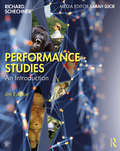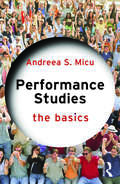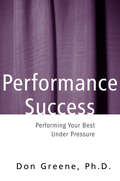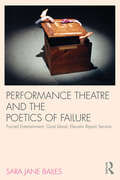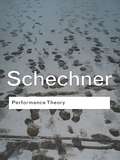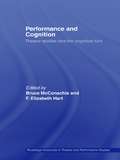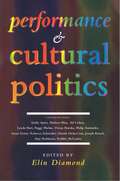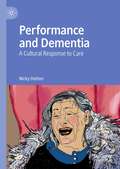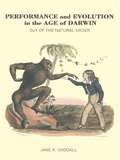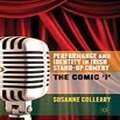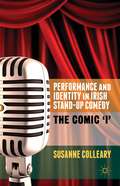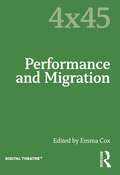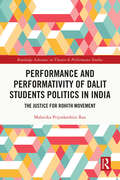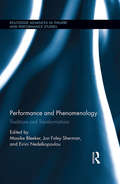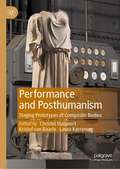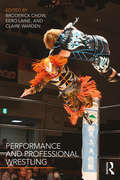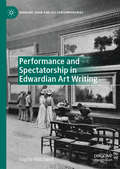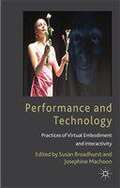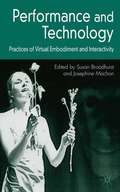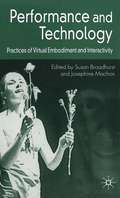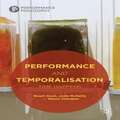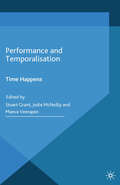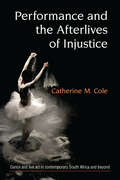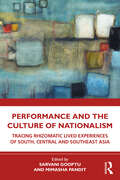- Table View
- List View
Performance Studies: An Introduction
by Richard SchechnerRichard Schechner's pioneering textbook is a lively, accessible overview of the full range of performance, with primary extracts, student activities, key biographies, and over 200 images of global performance. The publication of Performance Studies: An Introduction was a defining moment for the field. This fourth edition has been revised with two new chapters, up-to-date coverage of global and intercultural performances, and an in-depth exploration of the growing international importance of Performance Studies. Among the book’s topics are the performing arts and popular entertainments, rituals, play and games, social media, the performances of the paleolithic period, and the performances of everyday life. Supporting examples and ideas are drawn from the social sciences, performing arts, poststructuralism, ritual theory, ethology, philosophy, and aesthetics. Performance Studies: An Introduction features the broadest and most in-depth analysis possible. Performance Studies: An Introduction is the definitive overview for undergraduates at all levels and beginning graduate students in performance studies, the performing arts, and cultural studies. This new edition is also supported by a fully updated companion website, offering a variety of interactive resources, teaching tools, and research links.
Performance Studies: The Basics (The Basics)
by Andreea S. MicuPerformance Studies: The Basics offers an overview of the multiple, often overlapping definitions of performance, from performance art, performance as everyday life, and rituals, to the performative dimensions of identity, such as gender, race and sexuality. This book defines the interdisciplinary field of performance studies as it has evolved over the past four decades at the intersection of academic scholarship and artistic and activist practices. It discusses performance as an important means of communicating and of understanding the world, highlighting its intersections with critical theory and arguing for the importance of performance in the study of human behaviour and social practices. Complete with a helpful glossary and bibliography, as well as suggestions for further reading, this book is an ideal starting point for those studying performance studies as well as for general readers with an interest in the subject.
Performance Success: Performing Your Best Under Pressure
by Don GreenePerformance Success teaches a set of skills so that a musician can be ready to go out and sing or play at his or her highest level, working with energies that might otherwise be wasted in unproductive ways. This is a book of skills and exercises, prepared by a master teacher.
Performance Theatre and the Poetics of Failure
by Sara Jane BailesWhat does it mean to "fail" in performance? How might staging failure reveal theatre’s potential to expand our understanding of social, political and everyday reality? What can we learn from performances that expose and then celebrate their ability to fail? In Performance Theatre and the Poetics of Failure, Sara Jane Bailes begins with Samuel Beckett and considers failure in performance as a hopeful strategy. She examines the work of internationally acclaimed UK and US experimental theatre companies Forced Entertainment, Goat Island and Elevator Repair Service, addressing accepted narratives about artistic and cultural value in contemporary theatre-making. Her discussion draws on examples where misfire, the accidental and the intentionally amateur challenge our perception of skill and virtuosity in such diverse modes of performance as slapstick and punk. Detailed rehearsal and performance analysis are used to engage theory and contextualise practice, extending the dialogue between theatre arts, live art and postmodern dance. The result is a critical account of performance theatre that offers essential reading for practitioners, scholars and students of Performance, Theatre and Dance Studies.
Performance Theory
by Richard SchechnerFew have had quite as much impact in both the academy and in the world of theatre production as Richard Schechner. For more than four decades his work has challenged conventional definitions of theatre, ritual and performance. When this seminal collection first appeared, Schechner's approach was not only novel, it was revolutionary: drama is not just something that occurs on stage, but something that happens in everyday life, full of meaning, and on many different levels. Within these pages he examines the connections between Western and non-Western cultures, theatre and dance, anthropology, ritual, performance in everyday life, rites of passage, play, psychotherapy and shamanism.
Performance and Cognition: Theatre Studies and the Cognitive Turn (Routledge Advances in Theatre & Performance Studies)
by Bruce McConachie F. Elizabeth HartThis anthology is the first of its kind. In addition to opening up fresh perspectives on theatre studies – with applications for dramatic criticism, performance analysis, acting practice, audience response, theatre history, and other important areas – the book sets the agenda for future work, helping to map the emergence of this new approach. Following a comprehensive introduction, the contributors examine: the interfaces between cognitive studies and Lacanian psychoanalysis, phenomenology and communication theory different ideas from cognitive studies that open up the meanings of several plays the process of acting and the work of Antonio Damasio theatrical response: the dynamics of perception, and the riots that greeted the 1907 production of The Playboy of the Western World. This original and authoritative work will be attractive to scholars and graduate students of drama, theatre, and performance.
Performance and Cultural Politics
by Elin DiamondPerformance and Cultural Politics is a groundbreaking collection of essays which explore the historical and cultural territories of performance, written by the foremost scholars in the field. The essays, exploring performance art, theatre, music and dance, range from Oscar Wilde to Eric Clapton; from the Rose Theatre to U.S. Holocaust museums. The topic includes: * Sex Play: Stereotype, Pose and Dildo * Grave Performances: The Cultural Politics of Memory * Genealogies: Critical Performances * Identity Politics: Passing, Carnival and the Law In the concluding section, `Performer's Performance', performance artist Robbie McCauley offers the practitioner's perspective on performance studies. Interdisciplinary, thought-provoking and rich in new ideas, Performance and Cultural Politics is a landmark in the emerging field of performance studies.
Performance and Dementia: A Cultural Response to Care
by Nicky HattonThis book explores how theatre and performance can change the way we think about dementia and some of the environments in which dementia care takes place. Drawing on the author’s creative practice and other performance projects in the UK, it explores some of the challenges and opportunities of making performance in care homes. Rather than focusing on the transformative potential of the arts, it asks how artists can engage with the different types of relationships that exist in a care community. These include the relationships that residents and staff have with each other as well as relationships with care spaces. Exploring the intersection between participatory performance and the everyday creativity of a care home, it argues that the arts have a cultural role to play in supporting dementia care as a relational practice. Moreover, it celebrates the intrinsic creativity of caregiving and how principles and practices of care work can inform theatre and performance in diverse ways.
Performance and Evolution in the Age of Darwin: Out of the Natural Order
by Jane GoodallPerformance and Evolution in the Age of Darwin reveals the ways in which the major themes of evolution were taken up in the performing arts during Darwin's adult lifetime and in the generation after his death. The period 1830-1900 was the formative period for evolutionary ideas. While scientists and theorists investigated the law and order of nature, show business was more concerned with what was out of the natural order. Missing links and throwbacks, freak taxonomies and exotic races were favourite subject matter for the burgeoning variety theatre movement. Focusing on popular theatre forms in London, New York and Paris, Jane Goodall shows how they were interwoven with the developing debate about human evolution. With this book, Goodall contributes an important new angle to the debates surrounding the history of evolution. She reveals that, far from creating widespread culture shock, Darwinian theory tapped into some of the long-standing themes of popular performance and was a source for diverse and sometimes hilarious explorations.
Performance and Identity in Irish Stand-Up Comedy
by Susanne CollearyPerformance and Identity in Irish Stand-Up Comedy examines the comic tradition of stand-up in and from modern-day Ireland. Using critical analyses of comedians including Tommy Tiernan, Dylan Moran and Maeve Higgins, Susanne Colleary's engaging new book explores the role of stand-up in contemporary culture and examines the role of the staged comic self in performance. This book is suitable for students and scholars of international performance, and general readers interested in the interplay between comedy and society in contemporary cultural thought.
Performance and Identity in Irish Stand-Up Comedy: The Comic 'i'
by S. CollearyOne of the cultural phenomena to occur in Ireland in the last two decades has been the highly successful growth of stand-up comedy as a popular entertainment genre. This book examines stand-up comedy from the perspective of the narrated self, through the prism of the fabricated comedy persona, including Tommy Tiernan, Dylan Moran and Maeve Higgins.
Performance and Identity in the Classical World
by Anne DuncanActors in the classical world were often viewed as frauds and impostors, capable of deliberately fabricating their identities. Conversely, they were sometimes viewed as possessed by the characters that they played, or as merely playing themselves onstage. Numerous sources reveal an uneasy fascination with actors and acting, from the writings of elite intellectuals (philosophers, orators, biographers, historians) to the abundant theatrical anecdotes that can be read as a body of "popular performance theory. " This study examines these sources, along with dramatic texts and addresses the issue of impersonation, from the late fifth century BCE to the early Roman Empire.
Performance and Migration (4x45)
by Emma CoxThis third volume in the 4x45 series addresses some of the most current and urgent performance work in contemporary theatre practice. As people from all backgrounds and cultures criss-cross the globe with an ever-growing series of pushes and pulls guiding their movements, this book explores contemporary artists who have responded to various forms of migration in their theatre, performance and multimedia work. The volume comprises two lectures and two curated conversations with theatre-makers and artists. Danish scholar of contemporary visual culture, Anne Ring Petersen, brings artistic and political aspects of ‘postmigration’ to the fore in an essay on the innovations of Shermin Langhoff at Berlin’s Ballhaus Naunynstraße, and the decolonial work of Danish-Trinidadian artist Jeannette Ehlers. The racialised and gendered exclusions associated with navigating ‘the industry’ for non-white female and non-white non-binary artists are interrogated in Melbourne-based theatre scholar Paul Rae’s interview with two Australian performers of Indian heritage, Sonya Suares and Raina Peterson. UK playwrights Joe Murphy and Joe Robertson of Good Chance Theatre discuss their work in dialogue, and with their colleague, Iranian animator and illustrator Majid Adin. Emma Cox’s essay on Irish artist Richard Mosse’s video installation, Incoming, discusses thermographic ‘heat signatures’ as a means of seeing migrants and the imperative of envisioning global climate change. An accessible and forward-thinking exploration of one of contemporary performance’s most pressing influences, 4x45 | Performance and Migration is a unique resource for scholars, students and practitioners of Theatre Studies, Performance Studies and Human Geography.
Performance and Performativity of Dalit Students Politics in India: The Justice for Rohith Movement (Routledge Advances in Theatre & Performance Studies)
by Malavika Priyadarshini RaoThis book examines the significance of body, space, sound/voice/music and objects of resistance in everyday performance of Dalit student protests, focusing on the protests which erupted after Rohith Vemula, a Dalit PhD student, died,by suicide in Hyderabad Central University on 17 January 2016 in Hyderabad, India.Rohith’s death sparked national and international outrage and led to the shutdown of the University for over a month and gave rise to the ‘Justice for Rohith movement’, which continued for over a year. Rohith’s death became a symbolic representation of other Dalit deaths due to systemic caste violence; the symbolism of his death expanded to include other marginalised groups who have faced systemic violence historically. The author highlights five distinct aesthetics prominent in Dalit student activist performance practices: (1) folk performance traditions; (2) counter-interpretation and representation of Hindu mythology and Hinduism; (3) inspiration from Ambedkar and Buddhist iconography; (4) Christian church hymns; and (5) the text of Rohith’s last letter.In each chapter, the book explores how protesters draw on aesthetics and strategies from other political movements. This book will be of great interest to students and scholars in theatre and performance studies.
Performance and Phenomenology: Traditions and Transformations (Routledge Advances in Theatre & Performance Studies)
by Maaike Bleeker Jon Foley Sherman Eirini NedelkopoulouThis book offers a timely discussion about the interventions and tensions between two contested and contentious fields, performance and phenomenology, with international case studies that map an emerging 21st century terrain of critical and performance practice. Building on the foundational texts of both fields that established the performativity of perception and cognition, Performance and Phenomenology continues a tradition that considers experience to be the foundation of being and meaning. Acknowledging the history and critical polemics against phenomenological methodology and against performance as a field of study and category of artistic production, the volume provides both an introduction to core thinkers and an expansion on their ideas in a wide range of case studies. Whether addressing the use of dead animals in performance, actor training, the legal implications of thinking phenomenologically about how we walk, or the intertwining of digital and analog perception, each chapter explores a world comprised of embodied action and thought. The established and emerging scholars contributing to the volume develop insights central to the phenomenological tradition while expanding on the work of contemporary theorists and performers. In asking why performance and phenomenology belong in conversation together, the book suggests how they can transform each other in the process and what is at stake in this transformation.
Performance and Posthumanism: Staging Prototypes of Composite Bodies
by Christel Stalpaert Kristof Van Baarle Laura KarremanRecent technological and scientific developments have demonstrated a condition that has already long been upon us. We have entered a posthuman era, an assertion shared by an increasing number of thinkers such as N. Katherine Hayles, Rosi Braidotti, Donna Haraway, Bruno Latour, Richard Grusin, and Bernard Stiegler. The performing arts have reacted to these developments by increasingly opening up their traditionally ‘human’ domain to non-human others. Both philosophy and performing arts thus question what it means to be human from a posthumanist point of view and how the agency of non-humans – be they technology, objects, animals, or other forms of being – ‘works’ on both an ontological and performative level. The contributions in this volume brings together scholars, dramaturgs, and artists, uniting their reflections on the consequences of the posthuman condition for creative practices, spectatorship, and knowledge.
Performance and Professional Wrestling
by Claire Warden Broderick Chow Eero LainePerformance and Professional Wrestling is the first edited volume to consider professional wrestling explicitly from the vantage point of theatre and performance studies. Moving beyond simply noting its performative qualities or reading it via other performance genres, this collection of essays offers a complete critical reassessment of the popular sport.Topics such as the suspension of disbelief, simulation, silence and speech, physical culture, and the performance of pain within the squared circle are explored in relation to professional wrestling, with work by both scholars and practitioners grouped into seven short sections: Audience Circulation Lucha Gender Queerness Bodies Race A significant re-reading of wrestling as a performing art, Performance and Professional Wrestling makes essential reading for scholars and students intrigued by this uniquely theatrical sport.
Performance and Spectatorship in Edwardian Art Writing (Bernard Shaw and His Contemporaries)
by Sophie HatchwellThis book explores how Edwardian art writing shaped and narrated embodied, performative forms of aesthetic spectatorship. It argues that we need to expand the range of texts we think of as art writing, and features a diverse array of critical and fictional works, often including texts that are otherwise absent from art-historical study. Multi-disciplinary in scope, this book proposes a methodology for analyzing the aesthetic encounter within and through art writing, adapting and reworking a form of phenomenological-semiotic analysis found conventionally in performance studies. It focuses on moments where theories of spectatorship meet practice, moving between the varied spaces of Edwardian art viewing, from the critical text, to the lecture hall, the West End theatre and gallery, middle-class home, and fictional novel. It contributes to a rethinking of Edwardian culture by exploring the intriguing heterogeneity and self-consciousness of viewing practices in a period more commonly associated with the emergence of formalism.
Performance and Technology
by Susan Broadhurst Josephine MachonThis book, now in paperback, interrogates the interaction between new technologies and performance practice, linking the sensuous contact that exists between the physical and virtual, along with the resultant corporeal transformation. It features writings from international contributors specializing in digital art and performance practices. "
Performance and Technology: Practices of Virtual Embodiment and Interactivity
by Susan Broadhurst Josephine MachonPerformance and Technology.
Performance and Technology: Practices of Virtual Embodiment and Interactivity (Palgrave Studies In Performance And Technology Ser.)
by Susan Broadhurst Josephine MachonThis collection interrogates the interaction between new technologies and performance practice, linking the sensuous contact that must exist between the physical and virtual, together with the resultant corporeal transformation. It features writings from international contributors who specialize in digital art and performance practices.
Performance and Temporalisation
by Stuart GrantPerformance and Temporalisation features a collection of scholars and artists writing about the coming forth of time as human experience. Whether drawing, designing, watching performance, being baptised, playing cricket, dancing, eating, walking or looking at caves, each explores the making of time through their art, scholarship and everyday lives.
Performance and Temporalisation: Time Happens (Performance Philosophy)
by Jodie McNeilly Maeva VeerapenPerformance and Temporalisation features a collection of scholars and artists writing about the coming forth of time as human experience. Whether drawing, designing, watching performance, being baptised, playing cricket, dancing, eating, walking or looking at caves, each explores the making of time through their art, scholarship and everyday lives.
Performance and the Afterlives of Injustice (Theater: Theory/Text/Performance)
by Catherine ColeIn the aftermath of state-perpetrated injustice, a façade of peace can suddenly give way, and in South Africa and the Democratic Republic of Congo, post-apartheid and postcolonial framings of change have exceeded their limits. Performance and the Afterlives of Injustice reveals how the voices and visions of artists can help us see what otherwise evades perception. Embodied performance in South Africa has particular potency because apartheid was so centrally focused on the body: classifying bodies into racial categories, legislating where certain bodies could move and which bathrooms and drinking fountains certain bodies could use, and how different bodies carried meaning. The book considers key works by contemporary performing artists Brett Bailey, Faustin Linyekula, Gregory Maqoma, Mamela Nyamza, Robyn Orlin, Jay Pather, and Sello Pesa, artists imagining new forms and helping audiences see the contemporary moment as it is: an important intervention in countries long predicated on denial. They are also helping to conjure, anticipate, and dream a world that is otherwise. The book will be of particular interest to scholars of African studies, black performance, dance studies, transitional justice, as well as theater and performance studies.
Performance and the Culture of Nationalism: Tracing Rhizomatic Lived Experiences of South, Central and Southeast Asia
by Sarvani Gooptu and Mimasha PanditThis book studies the intersection of performance and nationalism in South Asia.It traces the emergence of the culture of nationalism from the late nineteenth century through to contemporary times. Drawing on various theatrical performance texts, it looks at the ways in which performative narratives have reflected the national narrative and analyses the role performance has played in engendering nationhood. The volume discusses themes such as political martyrdom as performative nationalism, the revitalisation of nationalism through new media, the sanitisation of physical gestures in dance, the performance of nationhood through violence in Tajiki films, as well as K-Pop and the new northeastern identity in India. A unique contribution to the study of nationalism, this book will be useful for scholars and researchers of history, theatre and performance studies, cultural studies, postcolonial studies, modern India, Asian studies, political studies, social anthropology and sociology.
